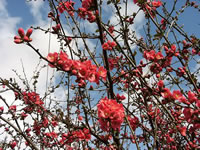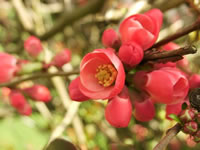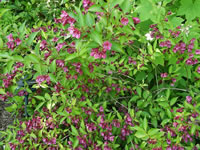How to Grow and Care for a Flowering QuinceChaenomeles speciosa |
||||
Growing Requirements for Flowering QuinceThis easy to care for, adaptable and nearly indestructible, deciduous shrub ishardy in USDA Zones 4-9 where it will grow from 5-10 ft. in height and width. Quince is easy to grow in almost any soil, as long as it is well drained and not overly-fertile. They will tolerate a wide range of soil pH from slightly alkaline to acidic. Flowering Quince can be grown in full sun or partial shade. Once established, Quince is a very drought tolerant plant.
|
||||
Forcing Flowering Quince Sprigs to Bloom IndoorsBy the end of the winter, most gardeners are longing to see a few fresh flowers.Branches can be cut from your Flowering Quince in late winter and forced to bloom indoors. The best branches for forcing are those near the top of the plant, with closely spaced flower buds. The larger the buds, the more quickly they'll open indoors. Trim any buds and side branches from the area of the stem that will be submerged in the water. Recut the stems at a long slant and place them in a vase of cold water in a cool place for two days. Recut the stem again and move it into a vase of warm, fresh water. Set the vase in a bright area and in about four weeks, you will have a beautiful red bouquet to brighten your day.
|
||||
Search The Garden Helper:



